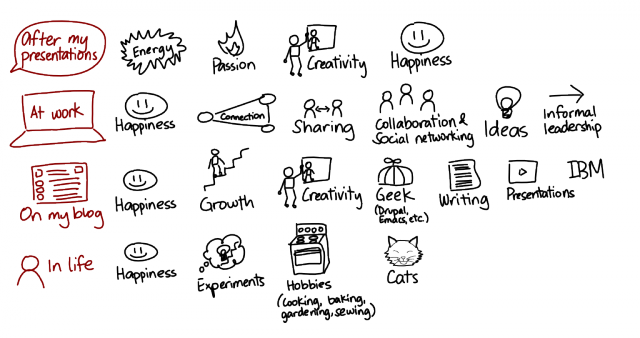Braindump: What I learned from our virtual leadership conversation
Posted: - Modified: | braindump, kaizen, leadershipAround 20 people joined us for a conversation about Smarter Leaders, which was organized by Jack Mason in the IBM Virtual Analytics Center. Rawn Shah and I gave introductory remarks, and then we facilitated small-group discussions. I focused on the need for smarter leaders at every level and what we could do to help people develop as leaders.
What did I learn?
We know what can help: identifying characteristics of effective leaders, focusing on leadership instead of technology, collecting and sharing success stories, compiling a cookbook that focuses on needs instead of tools… That part is just a matter of doing it, and there are lots of programs already underway.
Is it going to be enough, or are there other things we can do to break through? If it took e-mail ten or so years to become part of the corporate culture and enable all sorts of opportunities, can we wait that long for connected leadership to become part of the way we work?
We tend to have a culture of waiting for permission instead of experimenting (and asking for forgiveness if needed). This means that lots of people are waiting for their managers and executives to participate in this.
Me, I’m all for people taking responsibility for leadership at any level. We might not make big decisions, but we can still make a difference.
What am I going to do based on what I learned?
I’m going to take a look at the characteristics that describe IBMers at their best. I’m going to figure out how to develop those characteristics myself, and how other people can develop them.
I’m passionate about helping individual contributors build and demonstrate leadership. I’m neither a manager nor an executive, and I don’t want to wait for everyone at the top to “get it” before the benefits can trickle down to everyone else. So I’m going to keep poking this idea of leadership until more people can identify with it and ask themselves, “How can I be a smarter leader?”.
What are you going to do to spread be the word about smarter leaders? =)
What worked well? What could we improve further?
- I really liked being able to help bring together all these interesting people. It was like going to a real-life conference.
- I finished my part in time (short talk!). =) I forgot some of the points I wanted to make, but it was okay because I’d already shared them in my blog post.
- Small-group virtual facilitation needs to be tweaked further. I felt conscious about people being outside my vision, so I turned my avatar around, but it still felt strange to have my back to a speaker. We didn’t organize ourselves into a circle because it would’ve taken time to position people, and the spatial audio might’ve been weak. I like the way that our Second Life meeting environments sometimes have auto-expanding chairs.
- My audio was clipping because the sound was set too loud. I should definitely do more audio tests before the sessions.
- My sketches turned out pretty well on the screen of the Virtual Analytics Center. =) Simple and easy to see from any part of the auditorium.
- The auditorium turned out to be too small to accommodate breakout groups. One of the breakout rooms had audio running, and we couldn’t figure out how to turn it off. The big gathering area was a good place to have a discussion, though. Teleporting buttons would be a great way to get people from one place to the other without wasting time navigating. (Ooh, teleporting buttons with visual feedback for intuitive load-balancing…)
- The indicators for who was currently speaking made large conversations so much easier. I want that on all of my teleconferences. =)
- Text chat still beats speaking in turn when it comes to getting lots of stuff out. It’s odd to mix it in, though. It feels a little weirder than having an active backchannel during a phone conference. I think it’s because you can see people, so you feel more of an urge to talk to them instead of typing.
- The web.alive folks definitely need to add a way to save the text chat!
- The virtual environment can capture all sorts of interesting data. I wonder what kind of research can come out of this…
I did a good job of picking on people to get the ball rolling, and the conversation can get even better if I can figure out how to bring more people into the conversation.
Lots of good stuff!



